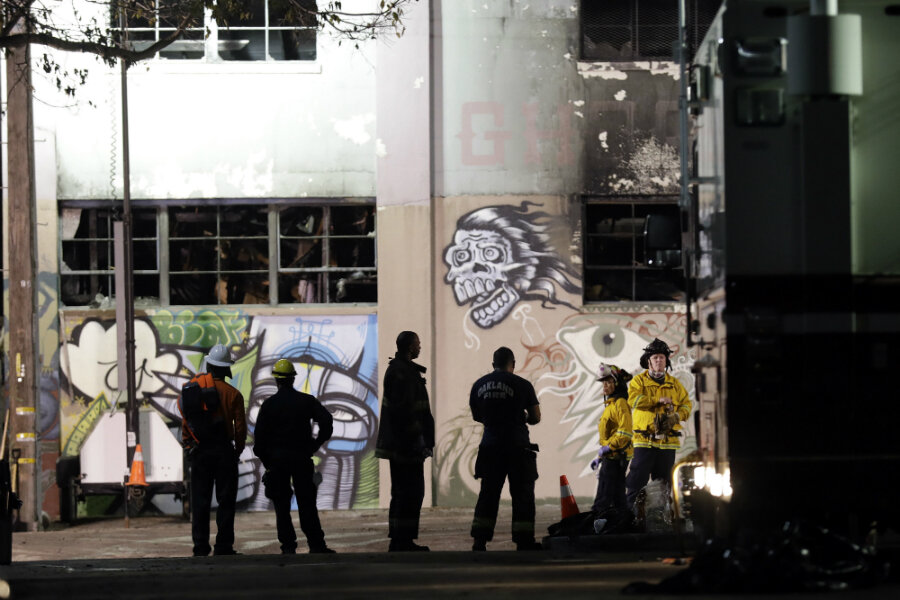Who should take responsibility for 'Ghost Ship' fire in Oakland?
Loading...
As investigators continue to comb through the charred rubble of a warehouse in Oakland, Calif., where at least 36 people were killed Friday when a fire tore through the illegal residence and artist collective during a dance party, they will seek the cause – and who is to blame for these deaths.
Fatal fires at nightclubs and other venues have historically spurred the public to insist upon better enforcement of fire codes, both in the United States and around the world. Given that local authorities had fielded a number of complaints about the so-called Oakland Ghost Ship, but failed to intervene before it burned, this latest disaster could prod the next round of reforms.
"That place was just a death trap," Shelley Mack, a former resident of the converted two-story warehouse told The Associated Press. "I didn't think it was going to last this long before it went up or somebody shut it down."
Ms. Mack, who paid about $700 per month to live there, said residents would rush to hide their clothes, bedding, and other personal belongings whenever outsiders or inspectors came to visit. Photos of the space from before the fire show it was packed with eclectic clutter, including old furniture, ornate rugs, musical instruments, and artwork that quickly fed the flames and made it difficult to evacuate, especially for nonresident partygoers.
"Even people who knew the building would have a hard time getting out," Danielle Boudreaux, a former friend of the couple who operated the warehouse, said. The operators constantly rearranged the floor plan, and they built an unstable staircase from the ground floor to the upstairs room where concerts were held, making the entire venue unsafe.
"Calling it a staircase gives you the idea that it was a set of stairs. It was not," Ms. Boudreaux added. "It was random pieces of wood put together to create something that you could get up to the top floor on. But it was not what most people would consider a staircase. It was like a jimmy-rigged makeshift staircase. As soon as you stepped on it, it wobbled all over the place."
Last month, Oakland planning officials opened an investigation into complaints from neighbors who said people were living in the warehouse illegally and allowing trash to pile up, but an inspector couldn't get inside, an official said. This came two years after the city inspected the property, based on a safety complaint from someone who attended a Ghost Ship party in December 2014, Boudreaux said.
In 2003, a fire at The Station nightclub in West Warwick, R.I., killed 100 people and injured 200 others after pyrotechnics during a show set fire to soundproofing foam. It remains one of the deadliest nightclub fires in world history, according to the National Fire Protection Agency (NFPA), and it prompted sweeping changes to the state's fire code.
"Unfortunately, it takes a terrible tragedy to get awareness out there," NFPA's Robert Solomon said at the time.
Despite the heightened awareness, loose regulation and lax enforcement have enabled a number of tragic accidents since. In 2004, a flare started a fire in an overcrowded nightclub, killing 194 in Buenos Aires, Argentina. In 2008, indoor fireworks led to 66 deaths at a New Year's Eve celebration in Bangkok, Thailand. In 2009, a plastic ceiling was set ablaze by indoor fireworks in Perm, Russia, killing 152 people. And, in 2013, more than 230 were killed when a fire broke out about 3 a.m. at a concert in Santa Maria, Brazil, marking the third-deadliest nightclub fire in world history.
These tragedies have had significant political ramifications. Following the 2009 fire in Russia, some pointed to government corruption, indifference, and alcohol-fueled fatalism.
Last year, when 32 people were killed in a nightclub fire in Bucharest, Romania, thousands took the streets calling for the government to resign because of corruption and poor safety supervision. Five days later, the prime minister complied with the protestors' demand, stepping down and taking his parliamentary government with him.
Permits would have been needed for the Oakland warehouse to be lawfully used as artist studies, for residential space, or for large parties, but none of those permits had been obtained, Oakland officials told USA Today. That means the Ghost Ship did not have permission from the local governing bodies to operate as witnesses said it was operating at the time of Friday's fire.
Assessing what degree of responsibility, if any, officials bear is a complicated process, as The Los Angeles Times reported. The list of people with ties to the building and the dance party is a long one, including the building owner, the group who leased the building, those who promoted the concert, individual artists who performed, and even their record company.
Although it is common for underground music venues and unpermitted dance parties to get by without the formalities of big-budget venues, David DeMember, a music industry veteran from the San Francisco Bay area, told the Times that he thinks the Ghost Ship was atypical in its poor safety.
"I wouldn’t have felt safe there," Mr. DeMember said. "I would have stood near the door."
Even so, DeMember predicted that the tragedy would prompt city officials to crack down on other unlicensed venues.
Material from The Associated Press was included in this report








